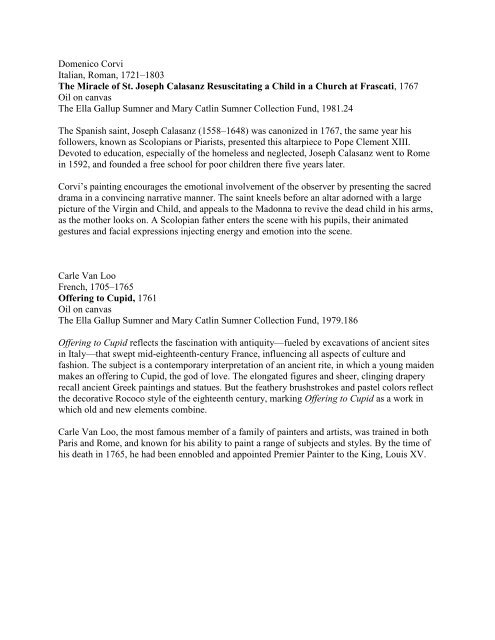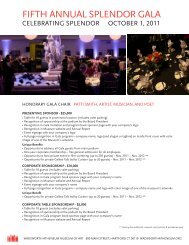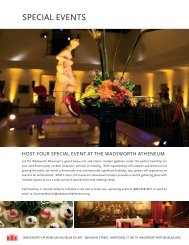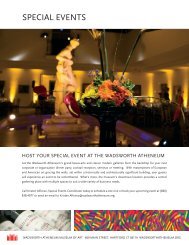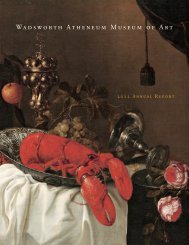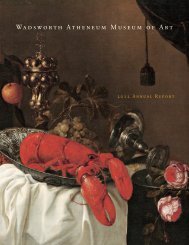The Age of Pleasure and Enlightenment European art of the ...
The Age of Pleasure and Enlightenment European art of the ...
The Age of Pleasure and Enlightenment European art of the ...
Create successful ePaper yourself
Turn your PDF publications into a flip-book with our unique Google optimized e-Paper software.
Domenico CorviItalian, Roman, 1721–1803<strong>The</strong> Miracle <strong>of</strong> St. Joseph Calasanz Resuscitating a Child in a Church at Frascati, 1767Oil on canvas<strong>The</strong> Ella Gallup Sumner <strong>and</strong> Mary Catlin Sumner Collection Fund, 1981.24<strong>The</strong> Spanish saint, Joseph Calasanz (1558–1648) was canonized in 1767, <strong>the</strong> same year hisfollowers, known as Scolopians or Piarists, presented this altarpiece to Pope Clement XIII.Devoted to education, especially <strong>of</strong> <strong>the</strong> homeless <strong>and</strong> neglected, Joseph Calasanz went to Romein 1592, <strong>and</strong> founded a free school for poor children <strong>the</strong>re five years later.Corvi’s painting encourages <strong>the</strong> emotional involvement <strong>of</strong> <strong>the</strong> observer by presenting <strong>the</strong> sacreddrama in a convincing narrative manner. <strong>The</strong> saint kneels before an altar adorned with a largepicture <strong>of</strong> <strong>the</strong> Virgin <strong>and</strong> Child, <strong>and</strong> appeals to <strong>the</strong> Madonna to revive <strong>the</strong> dead child in his arms,as <strong>the</strong> mo<strong>the</strong>r looks on. A Scolopian fa<strong>the</strong>r enters <strong>the</strong> scene with his pupils, <strong>the</strong>ir animatedgestures <strong>and</strong> facial expressions injecting energy <strong>and</strong> emotion into <strong>the</strong> scene.Carle Van LooFrench, 1705–1765Offering to Cupid, 1761Oil on canvas<strong>The</strong> Ella Gallup Sumner <strong>and</strong> Mary Catlin Sumner Collection Fund, 1979.186Offering to Cupid reflects <strong>the</strong> fascination with antiquity—fueled by excavations <strong>of</strong> ancient sitesin Italy—that swept mid-eighteenth-century France, influencing all aspects <strong>of</strong> culture <strong>and</strong>fashion. <strong>The</strong> subject is a contemporary interpretation <strong>of</strong> an ancient rite, in which a young maidenmakes an <strong>of</strong>fering to Cupid, <strong>the</strong> god <strong>of</strong> love. <strong>The</strong> elongated figures <strong>and</strong> sheer, clinging draperyrecall ancient Greek paintings <strong>and</strong> statues. But <strong>the</strong> fea<strong>the</strong>ry brushstrokes <strong>and</strong> pastel colors reflect<strong>the</strong> decorative Rococo style <strong>of</strong> <strong>the</strong> eighteenth century, marking Offering to Cupid as a work inwhich old <strong>and</strong> new elements combine.Carle Van Loo, <strong>the</strong> most famous member <strong>of</strong> a family <strong>of</strong> painters <strong>and</strong> <strong>art</strong>ists, was trained in bothParis <strong>and</strong> Rome, <strong>and</strong> known for his ability to paint a range <strong>of</strong> subjects <strong>and</strong> styles. By <strong>the</strong> time <strong>of</strong>his death in 1765, he had been ennobled <strong>and</strong> appointed Premier Painter to <strong>the</strong> King, Louis XV.


